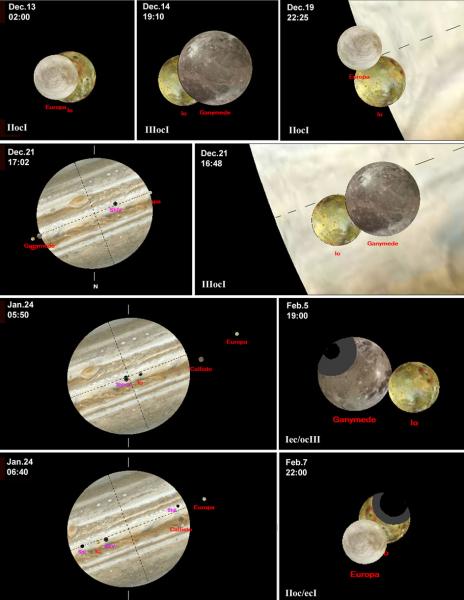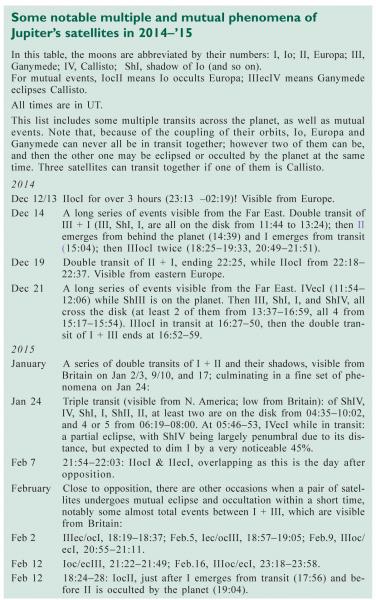Phenomena of Jupiter’s satellites in 2014-’15
2014 September 18
During the 2014-’15 apparition, the Jupiter system will be edge-on to the Earth and Sun, which allows observers to see fascinating phenomena of the Galilean moons.  This alignment allows the satellites and their shadows to transit across the planet’s Equatorial Zone so that observers have the greatest chance of seeing one or more of them on the disk. It also allows the moons to eclipse and occult one another in so-called ‘mutual phenomena’. These events can be followed even with modest telescopes, especially mutual eclipses where the rapid dimming of the eclipsed satellite can be seen even if it cannot be resolved. Larger telescopes do allow the moons to be resolved, and should allow some impressive images and even videos to be obtained.
This alignment allows the satellites and their shadows to transit across the planet’s Equatorial Zone so that observers have the greatest chance of seeing one or more of them on the disk. It also allows the moons to eclipse and occult one another in so-called ‘mutual phenomena’. These events can be followed even with modest telescopes, especially mutual eclipses where the rapid dimming of the eclipsed satellite can be seen even if it cannot be resolved. Larger telescopes do allow the moons to be resolved, and should allow some impressive images and even videos to be obtained.
This is an especially favourable series of mutual events; the jovian equinox (when the Sun crosses Jupiter’s equatorial plane) is on 2015 Feb 5, just one day before opposition on Feb 6, so there are many events while the planet is well placed. The first observable events are in 2014 September, and they continue until 2015 July. For observers in the UK, the best will be in February and March next year.
Full sets of predictions by Jean Meeus have been posted by the BAA Computing Section at:
http://britastro.org/computing/applets_jupiter.html
http://britastro.org/computing/handbooks_jocc2014.html
http://britastro.org/computing/handbooks_jecl2014.html
French astronomers have taken the lead in coordinating observations of these ‘phénomenes mutuelles’ (PhéMus): predictions and full details of the observing programme, called PHEMU2015, in English and French, are provided at:
http://www.imcce.fr/langues/en/observateur/campagnes _obs/phemu15/
For eclipses, the French predictions give longer durations because they include penumbral phases. For occultations, the two sets of predictions often differ by up to 20 seconds and sometimes more, as they were derived from different versions of the orbital elements. It is an exercise for the observer to discover which are more accurate.
The WinJUPOS program gives accurate graphical simulations of the events (Figure 1). Some of the more impressive combinations of events, especially those visible from Britain, are listed in Table 1 on the next page.
During the last edge-on apparition, in 2009, observers managed to obtain the first resolved time-lapse videos of mutual phenomena. These were collected on a website by Marc Delcroix of the Société Astronomique de France:
de France:
http://www.astrosurf.com/planetessaf/occultations/
This is a challenging task which requires a large telescope and good seeing. As the events happen quickly, the modern techniques of extensive image summation and de-rotation cannot be applied. (And please do not send synthetic images which aim to recreate the view – only real images!)
Observers who can do precision high-speed photometry are invited to contribute to the IMCCE programme. Those who obtain resolved videos are asked to send them to Marc Delcroix (delcroix.marc@free.fr) to be posted on his website.
Accurate photometric records of the events, particularly eclipses, with precise timings, can be useful in refining the orbits of the moons. For this purpose, the moons do not have to be resolved so a large telescope is not essential, but a good signal-to-noise ratio is required, and it is desirable to have another satellite in the field of view for comparison.
The BAA Jupiter Section will be pleased to receive copies of these results or web links to them, as well as snapshot images or visual observations by BAA members. We will update Section members by e-mail, and we will post selections of observations on the Jupiter Section website.
Good luck and clear skies to all!
John H. Rogers, Director, Jupiter Section
| The British Astronomical Association supports amateur astronomers around the UK and the rest of the world. Find out more about the BAA or join us. |
